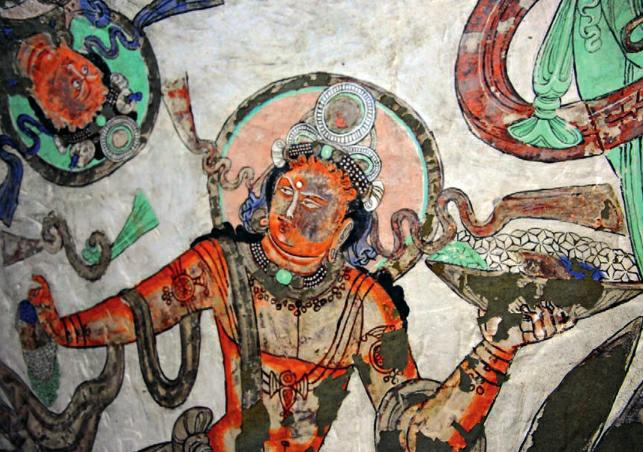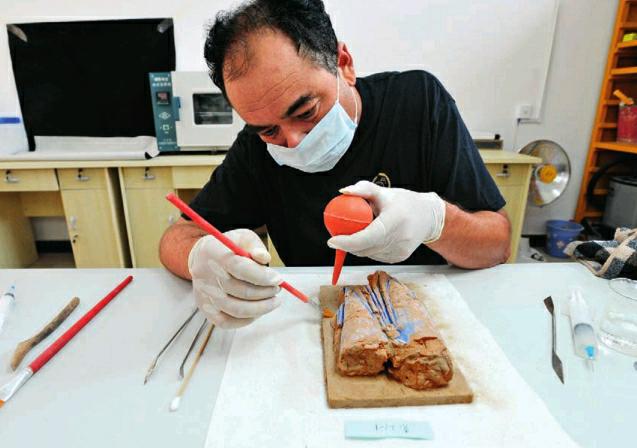The Glorious Kizil Grottoes
By+staff+reporter+YU+XIANGJUN
THE cliffs in which the Kizil Caves are embedded, near Baicheng County of Aksu Prefecture in Xinjiang Uygur Autonomous Region, emit a red glow under the sunlight. The color of the stone gives the caves its name, Kizil, which means red in the Uygur language.
The Kizil Caves, the largest cave network of its kind in the ancient kingdom of Kucha, form the most well-preserved grottoes in Xinjiang. With murals covering about 10,000 square meters, it is said to be a glorious art treasury second only to the Mogao Grottoes of Dunhuang. The earliest caves date back to the third century, but in the eighth and ninth centuries, the Kizil Caves were largely abandoned.
The location of the Kucha Kingdom was significant in ancient transportation and communication routes, making it a center for politics, economy, and culture in Chinas Western Regions. Before it spread to central China, Buddhism first arrived in Xinjiang from India and was localized in Chinas Western Regions. Kucha was a center for this local form of Buddhism, but at the same time it was a bridge that gave this religion access to central China. In Buddhism, grotto frescoes often serve as a major art form to expound doctrines.
Cave paintings in Kucha boast rich contents that depict not only the reincarnations of Buddhas, but also common peoples everyday life. Some experts claim that these caves constitute an encyclopedia on the Kucha culture. Chinas Western Regions were a melting pot for various cultures and art forms, which is why these murals are of an outstandingly high artistic level.
The grottoes at Kizil are considered to be the most impressive and remarkable of the Kucha period. They can be divided into two types – monksresidences and Buddhist halls. Monks dormitories are linked by corridors. The rooms are equipped with stoves, heated brick beds, and other simple facilities. The Buddhist halls are venues for religious services and sermons. Caves of different constructions and purposes were built in systematic ways and formed units.
Grottoes with columns are an architectural feature of the Kizil Caves. On the front wall of the main cell in this kind of grotto can be seen the image of Sakyamuni. The stories of this Buddha and his reincarnations are painted on the two side walls and on the ceiling. Following a clockwise direction from the main cell to the rear cell, visitors will see frescoes depicting the Buddhas nirvana. Back towards the main cell in this direction, frescoes showing another Buddha Maitreya sutra can be seen on the wall above.endprint
Murals in the Kizil Caves are painted in intense and bright colors, displaying striking and deliberate contrasts. Few colors were used, but the images have an irresistibly expressive force. Ancient artists used white powder and black ink as intermediate colors to balance different colors. Take the Apsaras painted on the ceiling of the rear cell in Cave 1, for example. Their ochre nude upper bodies and malachite green trousers present a contrast between warm and cool colors. However, their hair painted in black ink reconciles the color tones. Some ceiling paintings were colored in blocks of malachite green and cinnabar red, which would look rather thick and dark on their own. For better visual effect, painters sometimes dipped their brushes in white powder and added intricate patterns of plum blossoms, thus enlivening the color tones.
In addition, various color areas were often used in an alternate pattern. This style is prominent especially in ceiling paintings. The topmost of these arched caves are decorated with dozens of rhombic patterns, each with its own background color that decides its place on the walls.
In the main cell of Cave 38, 14 pairs of performing musicians are painted on the upper parts of two side walls, in each of which one has light skin and the other dark skin. The former have green aureoles above their heads, while those of the latter are white. Ancient painters paid great attention to contrasts in color tones and the brightness of each two adjacent colored areas. In terms of artistic methods, the Kizil Caves are the predecessors to the Mogao Grottoes and many other murals in temples in central China.
The Kizil Caves are compelling due to their long history and cultural value. However, when overseas expeditions arrived in the late 19th and early 20th century, they chipped off large fragments of the murals, leaving countless scars on the walls. Today, such fragments are exhibited in museums around the world. For instance, a considerable amount of frescoes, statues, and artworks in the Asian Art Museum in Berlin were brought to the country by explorer Albert von Le Coq in the early 1930s.
In 1985, the Institute of Kucha Caves Research was established in Xinjiang to carry out protection projects organized by the Chinese government and UNESCO. The institute looks after grottoes in the region and repairs those sites. Their efforts have saved murals and cultural relics from decaying.
Since the 1950s, Chinese researchers have been working hard to copy the frescoes. The reproductions stored in the Institute of Kucha Caves Re- search were mainly painted with water colors and gouache, which cannot be preserved permanently. In 2009, researchers at the institute adopted mineral pigments that are exactly the same as those that were used thousands of years ago. The blue comes from lapis lazuli, and red is extracted from cinnabar and lead tetroxide. The green is mainly made of dioptase. Paintings copied using these pigments have created an ideal effect.endprint

Some murals have suffered under the elements,as well as human activities. In November 2009, the Institute of Kucha Caves Research cooperated with the Chinese Academy of Cultural Heritage to set up plans to revive conservation of the Kizil grottoes. Fourteen caves whose murals had suffered the worst decay were chosen for the first phase of the conservation program. Launched in June 2012, this project combines traditional and up-to-date technologies to protect the frescoes, adhering to the principle of “stressing preservation, rescue first.”
The institute, moreover, endeavors to apply more modern technologies in archeological research. Their latest achievements include cooperation with a Shanghai-based digital graphic technology company. Constructions and murals in nine selected caves are scanned in digital and 3D formats to produce high definition pictures, which enable researchers to further compare the mural colors, make panoramas of frescoes, and produce digital models. Moreover, with the help of multispectrum technology, images that used to be blurry or indiscernible under natural light, including multi-layer murals, have now been made visible to the researchers.
During the 38th session of UNESCOs World Heritage Committee at Qatar, Doha on June 22, 2014, the Kizil Caves, as one of the sites on the Silk Road network, was added to UNESCOs World Heritage List. endprint
endprint

